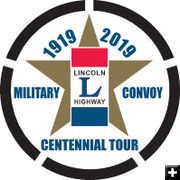100 Year Anniversary of Military Convoy and Lincoln Highway to be commemorated
annual conference in Rock Springs June 18-21
by Sweetwater County Historical Museum
March 10, 2019
SWEETWATER COUNTY — The U.S. Army’s groundbreaking 1919 Transcontinental Motor Convoy that crossed the United States from Washington, DC to San Francisco — ultimately a source of inspiration for the Interstate Highway System — passed through Sweetwater County.
The convoy’s mission was multi-faceted, but its basic goal was to test equipment and determine the feasibility of motorized cross-country travel. Eighty-one vehicles and trailers, including heavy cargo trucks, light trucks, water tankers, mobile machine shops, an "artillery wheeled tractor," cars, and motorcycles, manned by 24 officers and 258 enlisted men, covered the 3,200-plus miles from Washington to San Francisco in 62 days, sometimes at little better than a jogging pace.
Among the convoy’s officers was a future President of the United States; 29-year-old Lieutenant Colonel Dwight D. Eisenhower.
A century ago, road conditions west of the Mississippi were primitive. What would become the Lincoln Highway (U.S. Highway 30) and Interstate 80 in the west was often little more than series of dirt roads, rutted wagon trails, and abandoned railbeds. Breakdowns were constant, and bridges (14 in Wyoming alone) frequently had to be strengthened or repaired.
The convoy left Washington on July 7, 1919, and entered Wyoming a month later, on August 8. (In Cheyenne, the men were treated to a rodeo at Frontier Park.)
On August 13, the convoy reached Sweetwater County. As noted in its official log:
"At Creston Station a Class B truck slipped off the road and was helped back by another Class B… near Latham Station, [about 5 ½ miles west of present-day Creston Junction], Class B water tanker #80216 ran off road on abandoned railroad grade and rolled over 270 degrees, resting on left side. It was righted by 2 Class B’s, and proceeded under its own power in 20 min."
At Wamsutter, the convoy made numerous repairs and, three miles from Tipton, a mobile blacksmith vehicle sheared through a bridge’s floor planks and "narrowly averted dropping into 12′ ravine." That night the party "Camped on Red Desert, on barren, sandy plain, no inhabitants or buildings other than railroad personnel and property. Nearest natural water supply 16 miles."
The next day, the convoy "stopped for lunch at Point of Rocks," and proceeded from there to Rock Springs. The log noted that "The intensely dry air, absence of trees and green vegetation, and parched appearance of the landscape exerted depressing influence on personnel."
The night of August 14 was spent in Green River. At Granger, "a doubtful bridge about 60′ long was successfully passed by using great care." The convoy’s next stop was Fort Bridger. Three weeks later, it reached Oakland and was ferried across the Golden Gate to San Francisco.
Nearly 40 years later, as president, Eisenhower championed successful passage of the Federal Aid Highway Act of 1956, which created the Interstate Highway System – officially titled the "Dwight D. Eisenhower National System of Interstate and Defense Highways." Today the system features some 50,000 miles of interstate roadways nationwide. There is little doubt that Eisenhower’s participation in the 1919 convoy was a powerful influence in shaping his views on long-distance motorized travel and transport.
This year the Lincoln Highway Association is hosting a cross-country tour to commemorate the convoy’s 100th anniversary from August 31 to September 16. In addition, the Association will hold its annual conference in Rock Springs June 18-21. For more information, go to the Association’s website at www.lincolnhighwayassoc.org.
An excellent article about the 1919 convoy by Lori Van Pelt can be found on the Wyoming State Historical Society’s website, WyoHistory.org, at
www.wyohistory.org/encyclopedia/eisenhowers-1919-road-trip-and-interstate-highway-system.
|
